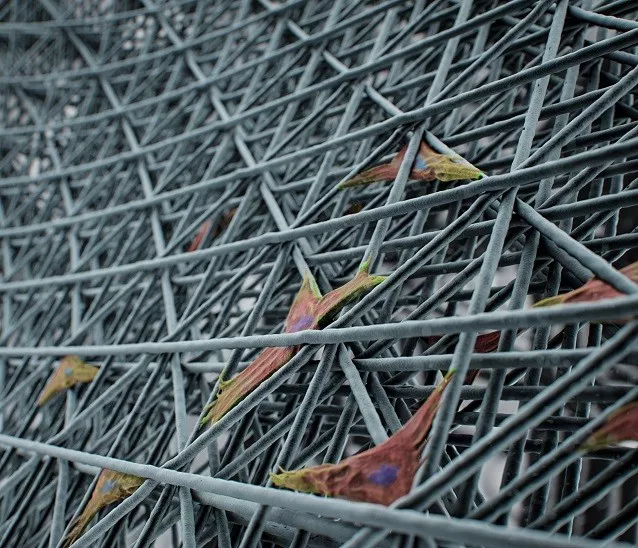论文标题:Machine learning metrology of cell confinement in melt electrowritten three-dimensional biomaterial substrates
期刊:Microsystems&Nanoengineering
作者:Filippos Tourlomousis, Chao Jia, Thrasyvoulos Karydis, Andreas Mershin, Hongjun Wang, Dilhan M. Kalyon, Robert C. Chang
发表时间:2019/03/25
数字识别码: 10.1038/s41378-019-0055-4
原文链接:https://www.nature.com/articles/s41378-019-0055-4?utm_source=sciencenet&utm_
medium=display&utm_content=mpu&utm_campaign=JRCN_2_JG_sciencenet_micronano_machine_learning
微信链接:https://mp.weixin.qq.com/s/JBE2RJRUXVGjPwoav4ndiQ
众所周知,细胞形状决定细胞功能。通过改变用于细胞操作的生物材料基底的生物物理特性来改变生物形状,从而实现编程细胞形态与功能的技术,在生物医疗等领域有重要价值和意义。
麻省理工学院比特和原子中心与新泽西州史蒂文斯技术学院的技术团队实现了利用熔融直写制造3D生物材料基底的技术,运用该技术可以通过控制特定的生物材料基底,生长出具有均匀大小和形状,以及特定功能的细胞。

图1
传统的3D打印技术所产生的细丝可以达到150微米(百万分之一米),细胞在该尺度的打印表面,就像在二维表面上一样,因为细胞本身比打印出的网状结构小很多。3D打印时,在挤出纤维和打印的过程中,给喷嘴之间增加一个强电场,打印出的纤维宽度可以达到10微米,该技术称为熔融直写技术。熔融直写技术可以生成与细胞同尺度的网状结构,从而为细胞生长提供一个真正的3D结构。细胞的许多功能受其微环境的影响,通过调节3D打印出的与细胞同尺度的多孔微结构,就可以实现对细胞尺寸、形状及其在材料基底上的粘合方式的控制,即制造具有特定大小、形状和特性的细胞。
该团队首先采用熔融直写技术得到各种特定结构的生物基底,然后使用共聚焦显微镜观察细胞在纤维中的生长,并采用人工智能方法对产生的大量的图像进行分析和分类,从而发现细胞类型及其可变性与其所生长的微环境的空间与纤维排列等特征间的关联。
细胞在其附着于结构的位置会形成称为“粘着斑”的蛋白质。粘着斑就像细胞与外界交流的“信使”,这种蛋白携带可被测量的特征;该团队通过量化粘着斑上的特征,并对这些特征进行计量分析,实现不同形状细胞的建模与分类。
此项研究表明,在给定的网状结构下,细胞生长出的形状与其基底结构和熔融直写结构直接耦合,并且,这种耦合性相比随机结构的网格具有高度的统一性,这种统一的细胞生长特性对生物医疗意义重大——实现了由形状驱动,具有很高重复性的精准设计与量化细胞的方法。
该团队将此项成果用于干细胞生长,结果表明,特定干细胞在本研究所得的三维网格中生长,比在传统二维结构中生长所保持特性的时间显著增长。该实验为此项技术在医学领域的应用提供了参考,可以采用此项技术培养具有特定功能的人类细胞,从而为移植与人造器官提供所需的材料。进一步明确细胞表型变化与三维打印的材料基底之间的耦合特性,是目前此项研究实现产业化应用的主要障碍。
本研究受国际媒体广泛关注,在MIT News,EurekAlert!,Phys.org,Science Daily,Azom.com,Nanowerk等媒体都有专门报道。该成果已发表在Microsystems & Nanoengineering上
摘要:Tuning cell shape by altering the biophysical properties of biomaterial substrates on which cells operate would provide a potential shape-driven pathway to control cell phenotype. However, there is an unexplored dimensional scale window of three-dimensional (3D) substrates with precisely tunable porous microarchitectures and geometrical feature sizes at the cell’s operating length scales (10–100 μm). This paper demonstrates the fabrication of such high-fidelity fibrous substrates using a melt electrowriting (MEW) technique. This advanced manufacturing approach is biologically qualified with a metrology framework that models and classifies cell confinement states under various substrate dimensionalities and architectures. Using fibroblasts as a model cell system, the mechanosensing response of adherent cells is investigated as a function of variable substrate dimensionality (2D vs. 3D) and porous microarchitecture (randomly oriented, “non-woven” vs. precision-stacked, “woven”). Single-cell confinement states are modeled using confocal fluorescence microscopy in conjunction with an automated single-cell bioimage data analysis workflow that extracts quantitative metrics of the whole cell and sub-cellular focal adhesion protein features measured. The extracted multidimensional dataset is employed to train a machine learning algorithm to classify cell shape phenotypes. The results show that cells assume distinct confinement states that are enforced by the prescribed substrate dimensionalities and porous microarchitectures with the woven MEW substrates promoting the highest cell shape homogeneity compared to non-woven fibrous substrates. The technology platform established here constitutes a significant step towards the development of integrated additive manufacturing—metrology platforms for a wide range of applications including fundamental mechanobiology studies and 3D bioprinting of tissue constructs to yield specific biological designs qualified at the single-cell level.
阅读论文全文请访问:https://www.nature.com/articles/s41378-019-0055-4?utm_source=sciencenet&utm_
medium=display&utm_content=mpu&utm_campaign=JRCN_2_JG_sciencenet_micronano_machine_learning
期刊介绍:Microsystems & Nanoengineering is an online-only, open access international journal devoted to publishing original research results and reviews on all aspects of Micro and Nano Electro Mechanical Systems from fundamental to applied research. The journal is published by Springer Nature in partnership with the Institute of Electronics, Chinese Academy of Sciences, supported by the State Key Laboratory of Transducer Technology.
(来源:科学网)
特别声明:本文转载仅仅是出于传播信息的需要,并不意味着代表本网站观点或证实其内容的真实性;如其他媒体、网站或个人从本网站转载使用,须保留本网站注明的“来源”,并自负版权等法律责任;作者如果不希望被转载或者联系转载稿费等事宜,请与我们接洽。